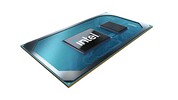AMD Ryzen 5 5600U vs Intel Core i5-1155G7
AMD Ryzen 5 5600U
► remove from comparison
The AMD Ryzen 5 5600U, not to be confused with Intel's Core i7-5600U, is a fairly fast Cezanne family processor designed for use in thinner, lighter laptops. The R5 5600U integrates six of the eight cores based on the Zen 3 microarchitecture and is the third fastest U-series processor at launch. The cores are clocked at 2.3 (guaranteed base clock) to 4.2 GHz (Turbo) and support SMT for a total of 12 threads. The chip is manufactured on the modern 7 nm TSMC process.
The new Zen 3 microarchitecture offers a significantly higher IPC (instructions per clock) compared to Zen 2. For desktop processors AMD claims 19 percent on average and in applications reviews showed around 12% gains at the same clock speed.
In addition to the six CPU cores, the APU also integrates a Radeon RX Vega 7 integrated graphics card with 7 CUs at up to 1800 MHz. The dual channel memory controller supports DDR4-3200 and energy efficient LPDDR4-4266 RAM. Furthermore, 16 MB level 3 cache (up from 8 MB at the 4800U) can be found on the chip.
Performance
This Ryzen 5 series chip is a solid mid-range CPU, as of early 2022. Its multi-thread benchmark scores nearly match those of the Intel Core i5-11400H (a much more power-hungry hexa-core chip designed for use in gaming laptops). While not nearly as fast as 12th generation Alder Lake-P processors, the 5600U should be good enough for the vast majority of users.
Thanks to its decent cooling solution and a long-term CPU power limit of 30 W, the IdeaPad 5 Pro 14ACN6 is among the fastest laptops powered by the 5600U that we know of. It can be more than 30% faster in CPU-bound workloads than the slowest system featuring the same chip in our database, as of August 2023.
Power consumption
This Ryzen 5 has a default TDP of 15 W, a value that laptop makers are allowed to change to anything between 10 W and 25 W with clock speeds and performance changing accordingly as a result. By going for the lowest value possible, it is possible to build a passively cooled system around this chip. Most laptop makers, however, will do the opposite to maximize performance.
The AMD Ryzen 5 5600U is built with TSMC's 7 nm manufacturing process for average, as of mid 2023, energy efficiency.
Intel Core i5-1155G7
► remove from comparison
The Intel Core i5-1155G7 is a power efficient quad-core SoC for laptops and Ultrabooks based on the Tiger Lake-U generation that was announced in mid 2021 as part of the refresh. It integrates four Willow Cove processor cores (8 threads thanks to HyperThreading). The base clock speed depends on the TDP settings and ranges from 1 GHz (12 Watt TDP) up to 2.5 GHz (28 Watt). Boost clock speed is 4.5 GHz.
Tiger Lake SoCs add PCIe 4 support (4 lanes), AI hardware acceleration, and the partial integration of Thunderbolt 4 / USB 4 and Wifi 6 in the chip.
Another novelty is the integrated Xe graphics adapter with 80 EUs based on the completely new Gen 12 architecture. It offers a significantly higher performance compared to the older Iris Plus G7 (Ice Lake).
Performance
The average 1155G7 in our database proves to be a very decent mid-range processor, as of mid 2022, trading blows with the Core i7-10810U and the Ryzen 5 4500U as far as multi-thread benchmark scores are concerned. While perhaps not the best option for power users, this Core i5 will make most consumers happy, providing for short load times and generally pain-free experience.
Your mileage may vary depending on how high the CPU power limits are and how competent the cooling solution of your system is.
Power consumption
This Core i5 series chip has a default TDP, also known as the long-term power limit, of 12 W to 28 W, the expectation being that laptop makers will go for a higher value in exchange for higher performance. Either way, this is a tad too high to allow for passively cooled designs.
The i5-1155G7 is built with Intel's third-gen 10 nm process marketed as SuperFin for lower-than-average, as of early 2023, energy efficiency.
| Model | AMD Ryzen 5 5600U | Intel Core i5-1155G7 | ||||||||||||||||||||||||||||||||||||||||||||||||
| Codename | Cezanne-U (Zen 3) | Tiger Lake-UP3 | ||||||||||||||||||||||||||||||||||||||||||||||||
| Series | AMD Cezanne (Zen 3, Ryzen 5000) | Intel Tiger Lake | ||||||||||||||||||||||||||||||||||||||||||||||||
| Series: Tiger Lake Tiger Lake-UP3 |
|
| ||||||||||||||||||||||||||||||||||||||||||||||||
| Clock | 2300 - 4200 MHz | 2500 - 4500 MHz | ||||||||||||||||||||||||||||||||||||||||||||||||
| L1 Cache | 384 KB | 320 KB | ||||||||||||||||||||||||||||||||||||||||||||||||
| L2 Cache | 3 MB | 5 MB | ||||||||||||||||||||||||||||||||||||||||||||||||
| L3 Cache | 16 MB | 8 MB | ||||||||||||||||||||||||||||||||||||||||||||||||
| Cores / Threads | 6 / 12 | 4 / 8 | ||||||||||||||||||||||||||||||||||||||||||||||||
| TDP | 25 Watt | 28 Watt | ||||||||||||||||||||||||||||||||||||||||||||||||
| Technology | 7 nm | 10 nm | ||||||||||||||||||||||||||||||||||||||||||||||||
| max. Temp. | 105 °C | 100 °C | ||||||||||||||||||||||||||||||||||||||||||||||||
| Socket | FP6 | BGA1449 | ||||||||||||||||||||||||||||||||||||||||||||||||
| Features | DDR4-3200/LPDDR4-4266 RAM, PCIe 3, MMX, SSE, SSE2, SSE3, SSSE3, SSE4A, SSE4.1, SSE4.2, AVX, AVX2, BMI2, ABM, FMA, ADX, SMEP, SMAP, SMT, CPB, AES-NI, RDRAND, RDSEED, SHA, SME | DDR4-3200/LPDDR4x-4266 RAM, PCIe 4, 4 GT/s bus, DL Boost, GNA, MMX, SSE, SSE2, SSE3, SSSE3, SSE4.1, SSE4.2, AVX, AVX2, AVX-512, BMI2, ABM, FMA, ADX, VMX, SMEP, SMAP, EIST, TM1, TM2, HT, Turbo, SST, AES-NI, RDRAND, RDSEED, SHA | ||||||||||||||||||||||||||||||||||||||||||||||||
| iGPU | AMD Radeon RX Vega 7 ( - 1800 MHz) | Intel Iris Xe Graphics G7 80EUs (400 - 1350 MHz) | ||||||||||||||||||||||||||||||||||||||||||||||||
| Architecture | x86 | x86 | ||||||||||||||||||||||||||||||||||||||||||||||||
| Announced | ||||||||||||||||||||||||||||||||||||||||||||||||||
| Manufacturer | www.amd.com | ark.intel.com |
Benchmarks
Average Benchmarks AMD Ryzen 5 5600U → 100% n=26
Average Benchmarks Intel Core i5-1155G7 → 91% n=26
* Smaller numbers mean a higher performance
1 This benchmark is not used for the average calculation












